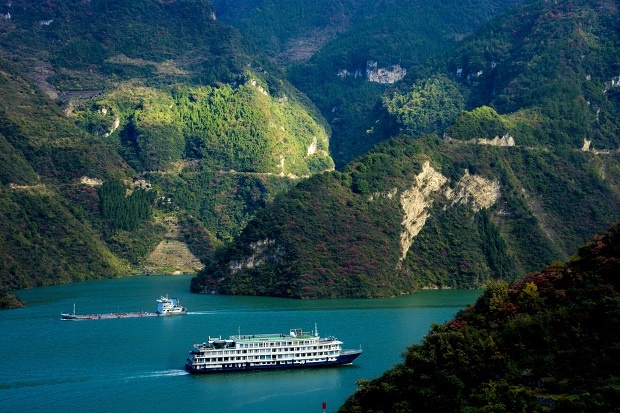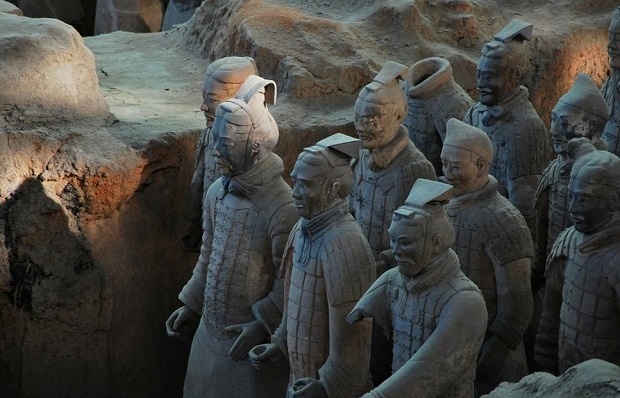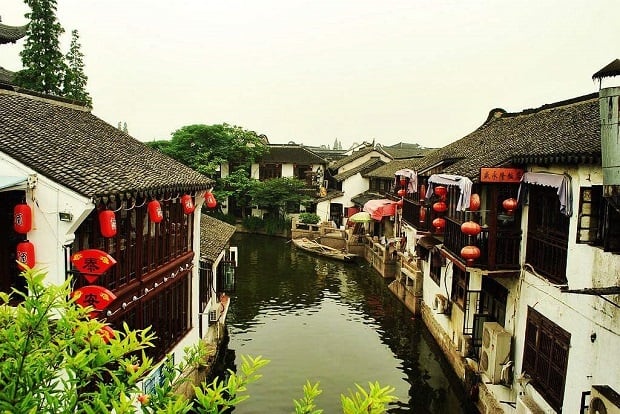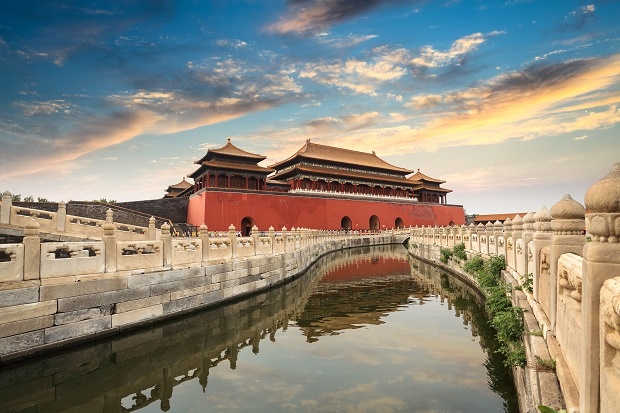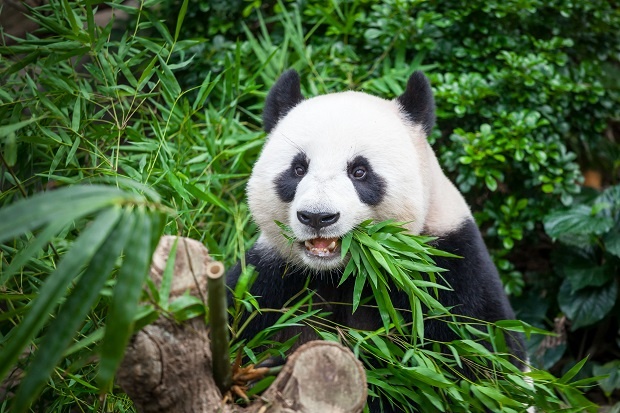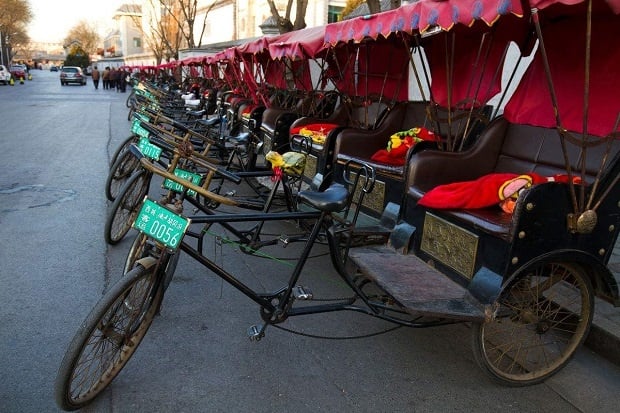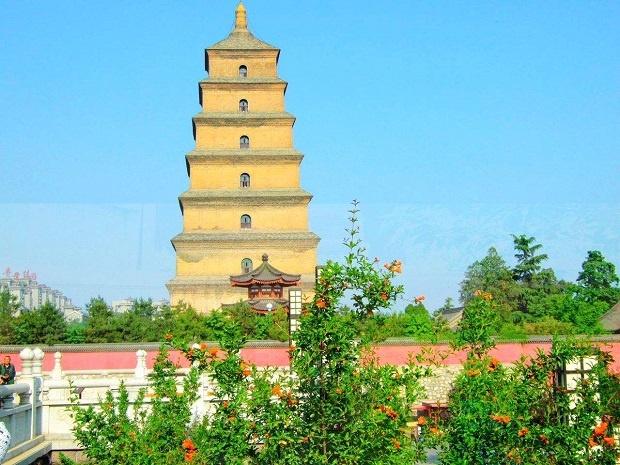Captivating China
- The Forbidden City
- Kung Fu Show
- Panda Base
- The Terracotta Warriors
- The Great Wall
- Cruise on the Yangtze River
- Tiananmen Square
- Dinner and Dance Show at Tang Dynasty Palace
Overview
China has a history of over 4 000 years. The country is one of the world’s four great ancient civilizations with a rich and colourful culture, very distinctive cuisine, old and modern art, beautiful countryside and amazing historical sites.
Your exploration starts in Beijing the capital city for over 800 years. Visit the Forbidden City, Tiananmen Square, Hutong and the Temple of Heaven. A visit is not complete if you have not been to a section of the Great Wall. In Xi’an the world famous Terracotta Warriors awaits as well as a visit to the Goose Pagoda. Chengdu is on the route for only one reason … Giant Pandas. You visit the Panda Base before embarking on a wonderful 3-night cruise on the Yangtze River. This amazing tour ends in the economical metropolis of China, Shanghai. Visit the Water Town, the Bund and end the tour with an evening cruise on the Huangpu River.
Itinerary
Day 0: Depart for China
Group will assemble at the airport. Depart on an overnight flight to Beijing.
Day 1: Arrive in Beijing
Arrive at Beijing Capital International Airport. Collect your luggage and meet your tour guide for transfer to your hotel. The guide will provide some useful travel information about the city en route to the hotel.
Check-in and time at leisure.
Tonight, we will have a welcome dinner and will enjoy Beijing roast duck.
O/N Novotel Xinqiao Hotel or similar (dinner)
Day 2: Beijing Highlights
Breakfast at the hotel and then a full day of sightseeing awaits. Our first stop is Tian’anmen Square and the Forbidden City.
Tian’anmen Gate is located at the centre of Beijing City and the midpoint of Chang’an Avenue, which runs from east to west through the city. From the eighth year of emperor Shunzhi's administration (1652), nearly all important imperial celebrations and events, such as the enthronement of an emperor, imperial weddings, the rite of the emperor going to battle, the famous "Imperial Edict Issued by the Golden Phoenix", the worship of Heaven and Earth, and the worship of the five grains, have involved passing through this gate.
The Square in the front of this gate is called Tian’anmen Square. Now Tian’anmen Square contains the monument to the heroes of the revolution, the Great Hall of the People, the National Museum of China and the Mausoleum of Mao Zedong. Mao Zedong proclaimed the founding of the People's Republic in the square on 1 October 1949.
The Forbidden City is in the north of Tian’anmen Square and is called Gu Gong in Chinese. It was the imperial palace for twenty-four emperors during the Ming and Qing dynasties. It took 14 years to build during the reign of Emperor Chengzu during the Ming Dynasty (1368-1644). Ancient Chinese astronomers believed that the Purple Star (Polaris) was in the centre of heaven and the Heavenly Emperor lived in the Purple Palace. The palace for the emperor on earth was then called the Purple Forbidden City. It was forbidden to enter without special permission of the emperor. Hence its name 'The Purple Forbidden City''. Since 1925 the city is open to the public for visits.
Enjoy lunch before continuing with the afternoon programme.
The Beijing Hutong (old lane) area has a very special and important place in the rich history and culture of the city. We visit the “old lane” and a local family. According to records the earliest Beijing Hutong originated in the Yuan Dynasty (1271-1368). Residential houses were set up side by side for high-ranking officials (usually a compound with a courtyard with one-story houses). Hutong was gradually adopted by old Beijing residents, and has been handed down to the present. The houses built on each side of Hutong are called Siheyuan (quadrangle) and are generally rectangular compounds, with buildings on four sides. Almost every quadrangle is surrounded by high walls. We will take a rickshaw to visit Hutong. You will then understand why people say that the real culture of Beijing is the culture of Hutong and the Courtyards.
The Temple of Heaven Park is located in the Chongwen District. It was built in the Ming Dynasty (AD 1420) by the emperor Zhu Di. Once a year, at winter solstice, the emperors came here to worship Heaven and to solemnly pray for a good harvest. Since his rule was legitimized by a perceived mandate from Heaven, a bad harvest could be interpreted as his fall from Heaven's favour and threaten the stability of his reign. So, it was not without a measure of self-interest that the emperor fervently prayed for a very good crop.
There are over 60,000 varieties of trees in die park. These trees create a quiet environment and an ideal atmosphere for the locals to do their morning exercise. Residents living nearby enjoy many activities in the park, such as running, cycling, singing, dancing, playing chess, flying kites, etc.
Enjoy dinner while enjoying breath-taking views of the city’s heart.
O/N Novotel Xinqiao Hotel or similar (breakfast, lunch, dinner)
Day 3: The Great Wall
Breakfast at the hotel.
Located in Huairou about 45 miles from Beijing, Mutianyu Great Wall enjoys a long history and is part of the glorious culture of China. It connects Juyongguan Pass in the west and Gubeikou Great Wall in the east. The wall was first built in 550 - 557. During the Ming Dynasty (1368 - 1644), Tan Lun and Qi Jiguang, two famous patriotic generals, rebuilt it in order to strengthen its defensive potential when they guarded the strategic pass. It served as the northern protective screen, guarding the capital and imperial mausoleums for generations.
Besides its strategically important location and compact layout, the Mutianyu Great Wall is also famous for the breath-taking scenery. Woods cover over ninety-six percent of the total scenic area. The different seasons present different views. Flowers bloom all over the mountains in spring. Grasses dress the hillside green in summer. Trees are laden with sweet fruits in autumn, and especially in October, leaves are turning red or yellow, touching the mountain tops with gold. In winter, the wall is covered by snow, making it seem mystical.
Enjoy lunch at a very unique restaurant, The Brickyard. It preserves the history of an important part of China’s rural outposts. Huairou District was a centre for producing glazed tiles used in palaces and temples during imperial times and the restaurant was once one of these factories producing tiles.
Tonight, we will attend a Kung Fu Show. A group of the best Kung Fu practitioners of China are collected and the best directors and designers of the country are invited by CHC. There are English subtitles shown above the stage to keep you informed of the storyline. There is no talking by the actors, just Kung Fu, dance and acrobatics. The fusion of modern dance with Chinese traditional martial arts makes this performance unique and spectacular. The Legend of the Kung Fu Show is a mixture of traditional martial arts and modern theatre. Presenting stunning Kung Fu skills, exquisite ballet and music, this beautiful story has become the most loved Kung Fu show in China. The story tells of a young boy who dreams of becoming a Kung Fu master. He takes the path of a monk in which he must face many obstacles both from this world and his own mind to overcome his fears and to become a true master of Kung Fu.
O/N Novotel Xinqiao Hotel or similar (breakfast, lunch, dinner)
Day 4: Xi’an
Breakfast and check-out. Transfer to the station and board the high-speed train to Xi’an. You will receive a lunch box to enjoy during the journey.
Arrive at Xi’an Train Station.
Xi'an is the capital of Shaanxi Province, located in the northwest of China, in the centre of the Guanzhong Plain. One of the oldest cities in China, the city was known as Chang'an before the Ming Dynasty. Xi'an is the oldest of the Four Great Ancient Capitals of China, having held the position under several of the most important dynasties in Chinese history, including Zhou, Qin, Han, Sui, and Tang. Xi'an is the starting point of the Silk Road and home to the Terracotta Army of Emperor Qin Shi Huang.
During the afternoon we will visit some of the city icons.
The Xi’an City Wall, located in the downtown area of Xi’an, is the largest in size and most well-preserved city wall in China.
It was built during the early Ming Dynasty on the foundation of the capital city Chang’an of the Tang Dynasty. The Xi’an City Wall measures 12 meters high, 12 to 14 meters wide on the top, 15 to 18 meters wide at the bottom with a total length of 13.7 kilometres. There is a watchtower every 120 meters, at the same height as the wall so that soldiers could attack enemies who were climbing the wall from inside the watchtower. The ancient city wall used to be an important part of the defence system. Now it provides valuable information for the study of military development as well as the architecture of ancient China.
The Great Mosque in Xian is one of the oldest, largest and best-preserved Islamic mosques in China with its location northwest of the Drum Tower (Gu Lou) on Huajue Lane. According to historical records engraved on a stone tablet inside, it was built in 742 during the Tang Dynasty (618-907). This was a result of Islam being introduced into northwest China by Arab merchants and travellers during the mid-7th century. In Xian, it is really well worth a trip to see the Great Mosque, not only for its century-old history, but also for its particular design of mixed architecture - traditional Muslim and Chinese styles. Occupying an area of over 12,000 square meters, the mosque is divided into four courtyards, 250 meters long and 47 meters wide. Landscaped with gardens, the further one strolls into its interior, the more serene it feels.
Check-in at your hotel. Dinner at a local restaurant.
O/N Sofitel Xi’an on Renmin Square or similar (breakfast, lunch box, dinner)
Day 7: Panda Base and start of Yangtze River Cruise
Breakfast and check-out.
Located just 10 km away from downtown, the Chengdu Research Base of Giant Panda Breeding has been created and imitates the natural habitat of giant pandas in order for them to have the best possible environment for rearing and breeding.
The giant pandas are not only a Chinese national treasure but are also beloved by people all over the world. They are found only in Sichuan, Shaanxi and Gansu Provinces. In total there are fewer than 2,000 left, of which 70% are found within the territory of Sichuan Province. Therefore, when visitors come to Chengdu their main focus will be to see these lovely animals.
Enjoy a light lunch.
After lunch transfer back to Chengdu. Board the high-speed train to Chongqing. Enjoy dinner at a local restaurant.
Embarkation at Chao Tian Men Dock for the start of the Yangtze River cruise.
The Yangtze is China’s lifeline. With its mainstream and tributaries, it runs through 18 provinces and cities and it divides China roughly into north and south. The most popular area is known as the Three River Gorges, a 160-km stretch between Nanjin Pass in the east and White King City in the west. Victoria Cruises is the only American cruise liner currently sailing China's Yangtze River. All the Victoria ships are rated five stars by The China National Tourism Administration. A Yangtze River Cruise will take you through the Three Gorges and the Three Gorges Dam, giving you the opportunity to see some of the most spectacular scenery imaginable.
O/N Shared cabin on Victoria Cruise Liner (breakfast, lunch, dinner)
Day 6: Chengdu
Breakfast and check-out.
Transfer to Xi’an Airport to check in for your flight to Chengdu. Arrive in Chengdu and transfer to your hotel.
Welcome to Chengdu! Chengdu is the capital of the Sichuan Province, which is known as the "Heavenly State" (Tian Fu Zhi Guo). Being the natural habitat of cute giant pandas, it is located in the west of the Sichuan Basin and in the centre of the Chengdu Plain. The Min and Tuo Rivers, two branches of the Yangtze River, connected to forty other rivers, supply an irrigation area of more than 700 square kilometres with 150-180 million kilowatts of water. Consisting of abundant mineral resources, the land is extremely fertile.
We enjoy lunch and later dinner at a local restaurant.
O/N Yinhe Dynasty Hotel or similar (breakfast, lunch, dinner)
Day 5: Terracotta Warriors
Breakfast at the hotel and then we depart to visit the Terracotta Army.
The Terracotta Army is referred to as "the eighth wonder of the world" and is a UNESCO world heritage and culture site. In March 1974 farmers from Xiyang Village, Yanzhai Township, Lintong County accidentally uncovered the sculptures in the pits when they were digging wells 1.5 km away from the Mausoleum of the First Qin Emperor. The three pits with a total area of 22,780 square meters are tagged Pit 1, Pit 2 and Pit 3 respectively in the order of their discovery. The terracotta warriors and horses are life-sized and were created using advanced techniques. When completed, the terracotta figures were placed in the pits in precise military formation according to rank and duty.
Enjoy lunch at a local restaurant.
During the afternoon we visit the symbol of the old-line Xian, the Big Wild Goose Pagoda (also called Giant Wild Goose Pagoda). It is a well-preserved ancient building and a holy place for Buddhists about 4 kilometres (2.49 miles) from the city centre. Standing in the Da Ci'en Temple complex, it attracts numerous visitors for its simple but appealing style of construction. It is rated as a National Key Cultural Relic as well as an AAAA Tourist Attraction. In addition, it was added to the World Heritage list on 22 June 2014, together with other sites along the ancient Silk Road.
Tonight, we will enjoy a dumpling dinner and dance show at the Tang Dynasty Palace.
O/N Sofitel Xi’an on Renmin Square or similar (breakfast, lunch box, dinner)
Day 11: Shanghai
Breakfast at hotel and transfer to Zhujiajiao Water Town. We will explore the water town by wooden boat.
Located in a suburb of Shanghai, Zhujiajiao is an ancient water town, with a history of more than 1,700 years. It is about 90-minutes’ drive from Shanghai. Unique features are old bridges across bubbling streams, small rivers shaded by willow trees, and houses with courtyards. In the town, there is a street filled with examples of ancient buildings from the Ming and Qing Dynasties.
Enjoy lunch at a local restaurant.
Transfer back to downtown Shanghai and visit the Bund.
The Bund, also called Zhongshan Dong Yi Lu, is a famous waterfront and regarded as the symbol of Shanghai for hundreds of years. Before the 1840s, the Bund was a muddy narrow lane with tall reeds. It initially became a British settlement. After Shanghai was established as the trading port in 1846, a street was paved and the riversides were reinforced. Then, rows of commercial buildings were constructed. A building boom at the end of 19th century and beginning of 20th century led to the Bund becoming a major financial hub in East Asia. The most famous and attractive sight is the west side where 26 buildings of different architectural styles including Gothic, Baroque, Romanesque, Classicism and the Renaissance can be seen.
Nanjing Road is the most famous shopping street in Shanghai, it is divided into Nanjing Road East and Nanjing Road West. The east section is the busiest shopping area in Shanghai, if not the busiest in China. On both sides of the road, there are many historic department stores, providing you with a wide choice of goods, food, electronics, clothes, etc.
The western part mainly boasts luxurious brand names and target big spenders. You can find a wide variety of world-famous brands in these spacious and well-arranged stores, such as Armani, LV, Prada and CD.
Enjoy an hour Huangpu River Night Cruise. The local people honour the Huangpu River as Mother River, and as you view the light spectacle from the deck of your evening cruise, you will understand why.
Dinner at a restaurant on the Bund.
O/N Shanghai Ocean Hotel or similar (breakfast, light lunch, dinner)
Day 8: Yangtze River Cruise
Breakfast on board.
Activities on the ship and buffet lunch.
Shore excursion – Shibaozhai (river conditions permitting): Shibaozhai is renowned for its impressive wooden pagoda appropriately named “The Pearl” of the Yangtze.
Captain’s Welcome Reception and Buffet Dinner.
Minorities and Dynasty Costume Show.
O/N Shared cabin on Victoria Cruise Liner (breakfast, lunch, dinner)
Day 12: Depart
At leisure until transfer to the airport to check-in for your flight home.
END OF TOUR
Day 10: Yangtze River Cruise - Shanghai
Breakfast on board.
Take a boat through the ship lock with a ship lift.
Shore excursion – Three Gorges Dam Site.
End of Victoria Cruise.
Transfer by road to Yichang.
Enjoy a light lunch and short city tour en route to the airport. Arrive at the airport and check-in for your flight to Shanghai.
Welcome to Shanghai. Shanghai is situated at the mouth of the Yangtze River, the longest river in China. It is the largest Chinese city and "a city of skyscrapers". With a history of more than 700 years, Shanghai was once the financial centre of the Far East. Today, Shanghai is the largest economic and transportation centre in China. The municipal government is working towards building Shanghai into a modern metropolis and into a world economic, financial, trading and shipping centre.
Met at the airport and transfer to hotel for check-in and dinner.
O/N Shanghai Ocean Hotel or similar (breakfast, light lunch, dinner)
Day 9: Yangtze River Cruise
Breakfast on board.
Sailing through Qutang Gorge.
Activities on the ship.
Scenic cruising – Wu Gorge.
Lunch.
Shore excursion – Goddess Stream.
Captain’s Farewell Banquet.
Crew cabaret.
O/N Shared cabin on Victoria Cruise Liner (breakfast, lunch, dinner)
Dates
On Request
Rates
On Request
Included
- All hotel accommodation as specified
- 3-Night cruise onboard the Victoria Line
- All meals as specified
- Hotel taxes
- Transport in an air-conditioned vehicle
- Local English-speaking guides
- Entrance fees for:
- Forbidden City
- Rickshaw tour at Hutong + visit to local family
- Temple of Heaven
- Mutianyu Great Wall with cable car tickets and shuttle bus
- Kung Fu Show
- Old City Wall Xi’an + bike to ride on the wall
- Great Mosque and Forest of Stele
- Terracotta Army
- Goose Pagoda
- Tang Dynasty Dance Show
- Panda Base (excluding cost for holding a Panda)
- Water Town wooden boat
- Huangpu River cruise
- Flight from Xi’an to Chengdu
- Flight from Yichang - Shanghai
- Train ticket: Chengdu - Chongqing
- Train ticket: Beijing to Xi’an
Excluded
- International flight costs and taxes
- Travel, medical and luggage insurance
- Visa cost
- Items of a personal nature
- Tips and gratuities
- Holding a Panda (From US$ 395.00)
Notes:
To ensure an in-depth experience of the local culture, history and traditions local expert guides will accompany you in the various areas that you will visit.
Prices for domestic flights, train tickets and park fees may be changed without prior notice. This is beyond our control and any increase levied will be payable by the traveller.
South African passport holders require a visa to visit China.
Compulsory vaccinations: yellow fever dependant on country of origin/stopover
China poses a malaria risk
Reservations
Fill out the form below to request a full itinerary.



